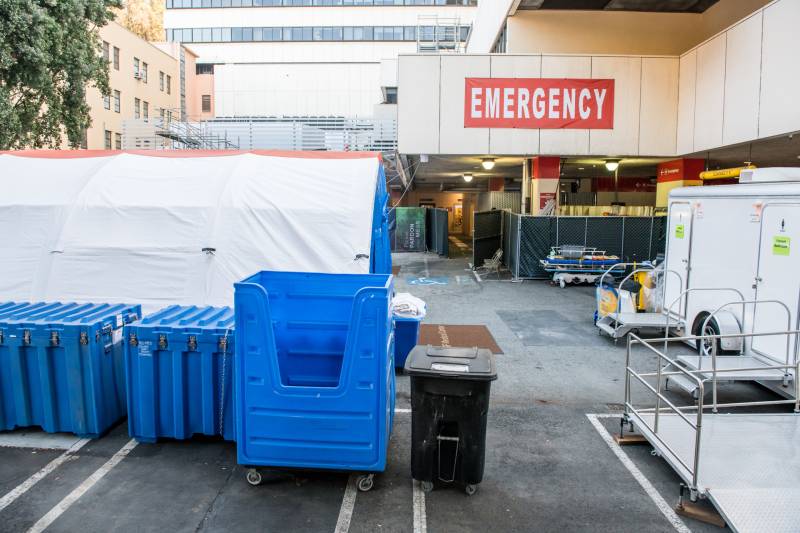Coyle argued in a recent blog post that what “transpired in Madera County will be replicated in other parts of California” unless the hospitals receive financial assistance from the state. The hospital association has asked the state for $1.5 billion in immediate relief.
“While the floodwaters of the COVID pandemic may have receded,” Coyle told KQED, “the damage that was done remains widespread. We have more than half of all California hospitals are operating in the red, losing money on every patient that they care for (PDF).”
Last year hospital margins in the Western United States were down 69% compared to 2019 (PDF). Coyle said that hospital profits being low or negative can lead to fewer nurses, X-ray technicians and behavioral health specialists, and reduced supplies like blood.
“These disruptions led to unexpected, unbudgeted cash shortfalls,” said Glenn Melnick, USC professor and health economist. “I think there will be more [hospitals] that just don’t have enough cash or financial reserves to weather the downturn.”
Even today, nearly three years after the pandemic started, many facilities are still depending on costly temporary or contract labor.
“The nurses all quit,” said Dr. Guy Shochat, who works in the ER at UCSF’s Parnassus campus in San Francisco. “We lost 20 nurses in the first year and a half of the pandemic. And they were senior nurses, so this was well over 200 years of institutional memory just disappearing. And it’s hurt us. Everyone’s just well and truly burnt out. And patient care suffers when staff are overwhelmed.”
This is especially true for emergency departments.
“There is no bed with which to see the patient,” said Dr. Nicole Braxley, an emergency medicine physician who worked in Sacramento during the pandemic and recently transferred to the East Coast. “And all I want to do is see the patient.”
She says patients all across the state and the country are waiting six, eight and sometimes 24 hours for care in the emergency department.
Lengthy wait times recently were driven partly by this winter’s tripledemic, when respiratory syncytial virus, or RSV, influenza and a wave of COVID-19 slammed the state, all at once. The problem gets exacerbated by the fact that many Californians do not have a primary care doctor. Not a new issue, this forces people to use the ER for all their medical needs. And emergency departments often cannot transfer patients to severely short-staffed rehabilitation hospitals or long-term care facilities.
According to a 2021 UCSF report, the percentage of registered nurses planning to retire by 2023 more than doubled in 2020 (PDF). And that was before the pandemic fueled a severe rise in burnout. The forecast for 2022 remained bleak, with a follow-up report (PDF) in 2022 stressing the “need to rapidly develop and implement strategies to mitigate the potential harm of shortages.”
Increasingly, hospitals are training doctors to treat people in the lobby of the ER.
“We call it vertical care,” Braxley said. “We say if a patient can stay vertical and they don’t need to be horizontal on a bed, they don’t get a bed. You sit in a chair.”
Patients can still receive blood tests, electrocardiograms and even an IV in the waiting room. Braxley says doctors use safety pins or coat hooks to hang IV bags. She admits lobby medicine is miserable for both patients and doctors, but it’s often the only option.
“Patients sit for days, unbathed, not ambulated, using urinals standing in corners in view of everyone. A patient I admitted three days ago stopped me, asking, ‘Why?’ Hands reach out from gurneys as I pass asking for food, water, help to the bathroom, a blanket, or someone to simply talk to and show they care,” wrote an ER doctor in a report titled A Nation in Crisis. The American College of Emergency Physicians published a collection of 100 harrowing stories from practitioners all across the country on the front lines.
Then, inflation gets added to the mix. Labor costs have increased by 19%. Pharmaceutical prices are up 40%. And finally, there’s Medi-Cal reimbursements: A third of Californians are enrolled in the state’s lower-income health plan.
“But the state pays only $0.74 for every dollar of care that’s provided to a Medi-Cal enrollee,” said Coyle.
Historically, private insurance payers typically make up Medi-Cal losses, but Coyle says that scale is beginning to tip in the wrong direction.
Many towns are in danger of losing critical medical services, like Kaweah Health in Tulare County, Hazel Hawkins Memorial Hospital in Hollister, and El Centro Regional Medical Center in Imperial County.
“When will this implode? It’s not a matter of if, but when will this implode?” Braxley said.

